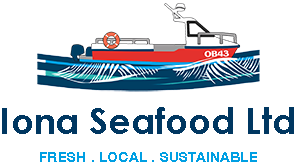A note about what we catch
All of our shellfish is sold live.
Our fish is always sold already gutted. If you would like the fish to have its head and/or tail removed or be scaled, please let us know when you place your order.
We can provide rough cooking times for shellfish, but these are intended as a guide only! There are plenty of recipe ideas and preparation tips on the internet. Have a look at our links page for some examples.
Langoustine
(Nephrops norvegicus)
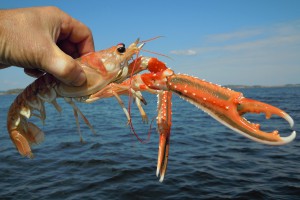
Also known as Prawns, Dublin Bay Prawn and Norway Lobster, Langoustine are our main target catch from Easter-October. We fish for them using creels (pots) that are placed on the sea floor. Prawns live on muddy ground in depths of 30-100m in our local waters. The prawns can be boiled, steamed or barbecued, with the tail providing most of the meat. The claw meat, although fiddly to extract, yields an even sweeter flesh.
Brown Crab
(Cancer pagurus)
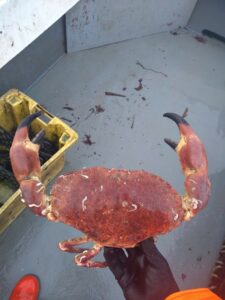
Brown Crab are the main target species of the larger boats in the local fishing fleet. You will often see boxes of them being landed on Fionnphort pier, destined to fill tins of crab meat or increasingly for the live export market to Europe or even China. Iona Seafood’s crab do not have to travel so far! We catch our crab using creels that are bigger and heavier than the prawn pots, and that are laid in shallower, rocky/sandy ground.
Male and female crabs give different levels of meat. Male (cock) crabs tend to have bigger claws, whilst the female (hen) crabs yield more meat from the body.
Lobster
(Homarus gammarus)
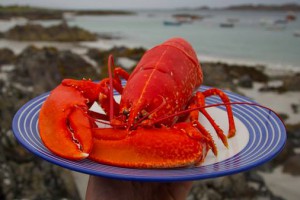
Pulling up a creel with a lobster in it is still an exciting sight. The majority that crawl into our creels are duly returned, as they are too small or are berried (egg carrying) females. The ones that are retained are in high demand, and understandably so, as they are easy to cook and yield delicious meat from the tail and claws. (The picture shows a cooked lobster, when alive they are a dark blue colour!)
Pollack
(Pollachius pollachius)

Known locally as Lythe, Pollack (shown here under some Mackerel) are the largest fish regularly caught by Iona Seafood, with good specimens reaching 6+ lb (2.7kg). We catch them using dive-boards, and the fish are killed, bled and chilled as soon as they are brought aboard, this preserves the flesh, especially important in white fish. The flesh of Pollack is similar to Cod, and can be baked, fried, or battered for delicious fish and chips! It also freezes well.
Saithe
(Pollachius virens)
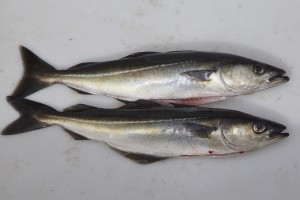
Saithe (also known as Coley/Coalfish) are the most common edible fish in our local waters. They are a member of the Cod family, and are known as Coalfish due to the darkish shade their flesh often has. Despite this, Saithe are a tasty fish when cooked well, and are an excellent budget option for those looking to experience local seafood.
Mackerel
(Scomber scombrus)
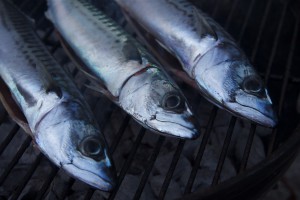
Shoals of mackerel usually arrive in the area in the summer, with numbers peaking in late July, early August. We use a hand-operated gurdy to catch mackerel, enabling large numbers to be caught in a short space of time if a shoal is found. Mackerel are a very versatile fish, they can be baked, grilled, barbecued or even eaten raw as Japanese style sashimi.
Velvet Crab
(Portunus puber)
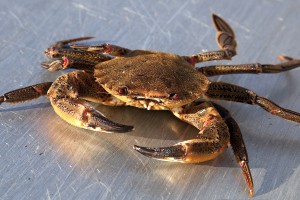
This is the main target species of the smaller boats (including us) in the local fishing fleet. Most velvet crabs are exported live to France or Spain. These feisty creatures have flat legs that enable them to swim through the water. It can be a fiddle to extract, but the reward is a sweeter meat than Brown Crab.
Fancy something completely different?
We occasionally catch the species below, mainly as bycatch in the creels. All are normally returned but if you would like to give them a try, get in touch!
Dogfish
(Scyliorhinus canicula)
Dogfish are a species of shark, and the Lesser Spotted Dogfish (or LSD for short) are very common in our waters. They are caught in the creels where they are attracted to the crab bait. The skin is tough to remove, but there are no bones to worry about!
Octopus
(Eledone cirrhosa)
Octopus are a species on the increase in our waters, and are caught in the creels, where they cause havoc by eating Crab and Lobster. Because of this, we are more than happy to sell Octopus if anyone wants to give it a try. They are sold already dead and with the yucky innards removed, meaning all you have to do is tenderise the meat and then cook!
Sea Urchin
(Echinus esculentus)
Sea Urchin roe is considered a delicacy and is sold for well over £100/kg online. Iona Seafood occasionally catch Urchins which have attached themselves to a creel. There is plenty of work involved in extracting the edible part but there are videos on the Internet to help with this!
Squat Lobsters
(Munida ragosa)
Contrary to their name, Squat Lobsters are nothing like an actual Lobster, and are more closely related to Crabs. They are found near the fishing grounds for Langoustine, and so occasionally if we don't get the Langoustine creels in the right place we catch Squat Lobsters instead. They perish quickly once out of the water, which is probably why they haven't become a commercially caught species. The tails yield bite size portions of sweet meat, and are Neil's favourite when cooked in Garlic Butter.
Winkles
(Littorina littorea)
Picking winkles is hard work and can only be done at low tide. Iona Seafood often pick winkles for a few days in the run-up to Christmas when the wholesale price goes up. If you want to give them a try we can pick some for you or give you guidance on how to do it yourself.
Spider Crab
(Maja brachydactyla)
Another species on the increase here. Why not try some 'Hebridean King Crab'?! Males have good size claws with tasty meat, and the bodies of both sexes have meat if you spend a little time extracting it.
